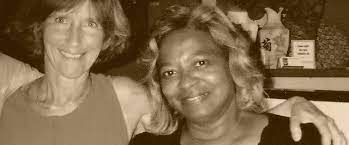
Work that happens inside the home is intimate and personal. Yet so many employers remain disconnected from the domestic workers they hire, and there are often barriers to building strong working relationships. Many house cleaners for example, never physically see their employers, who often schedule cleanings when they are not home. Language and cultural barriers can make communication challenging. And the power dynamic between workers and employers can make both feel uncomfortable at best, and lead to exploitation and abuse at its worst.
Yet despite these barriers, there are so many stories that show a deep connection between domestic workers and the families they support. The friendship between Wendy Sanford and Mary Norman is one of them. Their story is documented in the recent book, These Walls Between Us. I had the privilege of meeting with them both to talk about the book.
Wendy clarified that this book is a co-creation between her and Mary. Wendy recalled that the idea for the book came during a walk with Mary. “Mary said we should write a book about our friendship because no one would believe it. Mary said, it will make us a lot of money. We now realize it won’t, but oh well! And then Mary said, maybe it’ll get us on Oprah, because Oprah’s show had just started that year so that’s how we could time exactly when the book started.”
Mary and Wendy met in 1956 when Wendy’s family hired Mary to become a live-in domestic worker in their vacation home in Nantucket. Mary was 15, Black, and had recently moved from the Jim Crow south. Wendy was 12, from a white privileged New England family. Like many employers at the time, Wendy’s parents understood very little about Mary or how their actions impacted her. For example, they thought nothing about hiring a white off-duty police officer to transport Mary to and from their home to the ferry. Mary remembers wondering “Will I be okay so far from home?”
Like many domestic workers of that time, Mary took on a long list of household duties— cooking, vacuuming, making beds, ironing, and caring for the family. Her work was essential, but also invisible. Mary wasn’t allowed to eat with the family. Mary was also expected to be available at all times, and recalled having to cancel any personal plans she might have if the family needed her to take care of something.
Mary was paid typically low wages for her work, similar to domestic workers today. Mary remembered telling Wendy’s mother casually, that she was glad on payday, because she didn’t have “any money in the bank at all.” Wendy’s mother was startled and confused, unaware of Mary’s experience.
Mary continued to support the family through part-time work for decades. As Mary and Wendy grew into their thirties, both becoming divorced single parents, they began to learn about each other as peers and built a lasting friendship despite the barriers that surrounded them. Both were aware that Wendy’s parents “didn’t like” the two of doing things together, like taking walks on the beach. It often felt like they were sneaking behind her parents’ back, and breaking long-held “rules” rooted in white supremacy and racial segregation, in order for the two of them to create a relationship.
In the book and in our conversation, Wendy acknowledges the role the friendship played in leading her to confront her own internalized racism and white fragility. She talked about the mistakes she made, such as avoiding the topic of race in their conversations for fear of offending Mary. It was a breakthrough moment for Wendy to “stop walking on eggshells” and being afraid of acknowledging the impact of racism and privilege on both their lives.
In reflecting on this recent period with attacks on our democracy and a resurgence of violent racism, Mary argued that instead of returning to a time when America was only great for white people, we must work for “togetherness” not just for people of color but for the soul of our nation. We must be bold in breaking the rules as Mary and Wendy did in building their relationship together.

With this book, Wendy and Mary have not only had the opportunity to share the story of their friendship, but have also been able to connect with others with similar experiences. When I spoke with Wendy and Mary about Hand in Hand’s work, they stressed the importance of our organization’s role in dismantling the legacy of white supremacy through organizing employers to fight alongside workers for fair wages and benefits.
These Walls Between Us can be found at independent booksellers like Bookshop.com.
